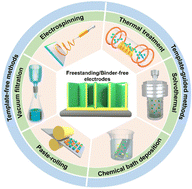Rational fabrication strategies of freestanding/binder-free electrodes for efficient capacitive deionization
Abstract
Capacitive deionization (CDI) has received enormous attention as an emerging desalination alternative owing to the efficient energy footprint, low capital cost, and environmental friendliness. Conventionally, CDI electrodes are mainly fabricated using the slurry-coated method, through which insulated polymeric binders are utilized to integrate the active materials in powdery form and the conductive agents, thereby leading to inferior conductivity and poor cycling lifespan. Recently, freestanding/binder-free electrodes have provided great opportunities to improve the CDI performance due to the enhanced conductivity and stability. In this review, we show a comprehensive overview of the recent advances in the fabrication strategies (e.g., template-free, template-guided, and other less-common methods) of freestanding electrodes for CDI. Besides, we also highlight the related deionization performance metrics, including the ion removal capacity, rates, efficiency, and energy consumption. Furthermore, we discuss the remaining challenges and further outlooks for the continued development of freestanding electrodes for CDI applications.

- This article is part of the themed collection: Recent Review Articles


 Please wait while we load your content...
Please wait while we load your content...